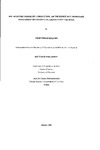SOIL MOISTURE VARIABILITY: IMPLICATIONS FOR THE HYDROLOGY, EROSION AND MANAGEMENT OF GULLIED CATCHMENTS IN CENTRAL SPAIN
| dc.contributor.author | FITZJOHN, CHRISTOPHER | |
| dc.contributor.other | School of Geography, Earth and Environmental Sciences | en_US |
| dc.date.accessioned | 2013-10-22T09:19:06Z | |
| dc.date.available | 2013-10-22T09:19:06Z | |
| dc.date.issued | 1999 | |
| dc.identifier | NOT AVAILABLE | en_US |
| dc.identifier.uri | http://hdl.handle.net/10026.1/2269 | |
| dc.description.abstract |
In semi-arid environments, the combination of a non-uniform distribution of vegetation, an often highly irregular terrain and complex geological, pedological and management histories have frequently given rise to considerable spatial variability in the physical and hydrological properties of soils. Heterogeneity within the soil's physical and hydrological properties can result in pronounced differences in infiltration and soil moisture. The hydrological response of semi-arid landscapes to rainfall events may therefore be spatially non-uniform. Quantifying the spatial pattern of hydrological response is important for identifying those areas within the landscape which arc vulnerable to runoff and erosion. Since soil moisture is considered to be a key factor in determining hydrological response and its spatial distribution is a function of the soil's physical and hydrological properties, the spatial and temporal measurement of soil moisture may be used to identify contrasting areas of hydrological response. In a badlands environment located approximately 70 km north of Madrid, central Spain, an experiment was established to describe the temporal and spatial variability in soil moisture at three scales, with the primary aim of furthering the understanding of the hydrological and geomorphological processes operating in semi-arid landscapes. At each measurement scale, the macroscale (25m sampling interval), the mesoscale (gully catchments, 5m sampling interval) and the microscale (1 m sampling interval), two distinct groups of soil moisture conditions emerged related to dry and wet weather conditions. At each measurement scale the maximum variability in soil moisture is similar (>20% volumetric content difference between immediately adjacent sampling points). At the meso and microscale the spatial pattern of soil moisture could be described as a mosaic pattern which during the dry period was more fragmented and variable than during the wet period. The spatial pattern of soil moisture during wet conditions is more uniform due to the development of extensive wet areas within the catchments. During these conditions the range of spatial correlation in soil moisture may double (to greater than 30m) compared to dry conditions, indicating an increase in the spatial continuity of soil moisture. The spatial variability in soil moisture therefore displays a temporal dependency; the mosaic soil moisture pattern is more fragmented and spatially discontinuous during dry than wet conditions. A striking characteristic of the study area is the near horizontal interbedding of sediment horizons which may strongly contrast in their textural composition over relatively short distances. This variability in soil texture and the associated changes in pore size characteristics, were the principal controlling factors in determining the spatial patterns of soil moisture and overrides the known influence of vegetation and topography on soil moisture. During dry conditions the non-uniform uptake of soil moisture by vegetation may partly explain the greater variability in soil moisture observed during this period. The mosaic patterns of soil moisture represent areas of contrasting hydrological response. During dry periods when the mosaic pattern is more fragmented, source areas of overland flow are spatially isolated and surrounded by 'sink' areas capable of re-absorbing runoff and sediment deposition. Hydrological pathways are therefore discontinuous resulting in minimal runoff reaching the catchments channels. Since soil moisture values during this period are below saturation, any runoff which does occur is generated as infiltration excess overland flow. In semi-arid areas spatial variability in soil properties or vegetation patterns may therefore be beneficial for runoff and erosion control by creating a self-regulating system in which runoff producing areas are surrounded by buffer zones capable of re-absorbing the runoff. During wet periods extensive areas of the catchments may be saturated. source areas are no longer spatially isolated and continuous hydrological pathways may develop rapidly during this period. During the wet period when conditions arc above a critical saturation threshold value widespread runoff will occur regardless of the spatial variability in the soil's physical and hydrological properties. The creation of a mosaic pattern in which buffer zones are adjacent to potential runoff producing areas, as identified from spatial soil moisture patterns, may provide the most effective management strategy in runoff and erosion control for degraded semi-arid environments. The creation of a mosaic pattern is most applicable at the watershed scale allowing several land uses, including those which are potentially degrading, to co-exist. Increasing the critical threshold value above which widespread runoff occurs should also.be included as part of this management strategy. | en_US |
| dc.language.iso | en | en_US |
| dc.publisher | University of Plymouth | en_US |
| dc.title | SOIL MOISTURE VARIABILITY: IMPLICATIONS FOR THE HYDROLOGY, EROSION AND MANAGEMENT OF GULLIED CATCHMENTS IN CENTRAL SPAIN | en_US |
| dc.type | Thesis | |
| dc.identifier.doi | http://dx.doi.org/10.24382/3755 | |
| dc.identifier.doi | http://dx.doi.org/10.24382/3755 |
Files in this item
This item appears in the following Collection(s)
-
01 Research Theses Main Collection
Research Theses Main


